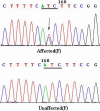A novel GJA8 mutation (p.I31T) causing autosomal dominant congenital cataract in a Chinese family
- PMID: 20019893
- PMCID: PMC2794658
A novel GJA8 mutation (p.I31T) causing autosomal dominant congenital cataract in a Chinese family
Abstract
Purpose: To identify the genetic defect associated with autosomal dominant congenital nuclear cataract in a Chinese family.
Methods: Family history and clinical data were recorded. The genomic DNA was extracted from peripheral blood leukocytes. All the members were genotyped with microsatellite markers at loci considered to be associated with cataracts. Two-point logarithm of odds (LOD) scores were calculated by using the Linkage software after genotyping. Mutations were detected by DNA sequence analysis of the candidate genes. Effects of amino acid changes on the structure and function of proteins were predicted by bioinformatics analysis.
Results: Evidence of a linkage was obtained at markers D1S514 (LOD score [Z]=3.48, recombination fraction [theta]=0.0) and D1S1595 (Z=2.49, theta=0.0). Haplotype analysis indicated that the cataract gene was close to these two markers. Sequencing of the connexin 50 (GJA8) gene revealed a T>C transition at nucleotide position c.92. This nucleotide change resulted in the substitution of highly conserved isoleucine by threonine at codon 31(I31T). This mutation co-segregated with all affected individuals and was not observed in unaffected or 110 normal unrelated individuals. Bioinformatics analysis showed that a highly conserved region was located at Ile31, and the mutation was predicted to affect the function and secondary structure of the GJA8 protein.
Conclusion: A novel mutation in GJA8 was detected in a Chinese family with autosomal dominant congenital nuclear cataract, providing clear evidence of a relationship between the genotype and the corresponding cataract phenotype.
Figures





Similar articles
-
A novel mutation in GJA8 causing congenital cataract-microcornea syndrome in a Chinese pedigree.Mol Vis. 2010 Aug 11;16:1585-92. Mol Vis. 2010. PMID: 20806042 Free PMC article.
-
A novel mutation in the connexin 50 gene (GJA8) associated with autosomal dominant congenital nuclear cataract in a Chinese family.Curr Eye Res. 2010 Jul;35(7):597-604. doi: 10.3109/02713681003725831. Curr Eye Res. 2010. PMID: 20597646
-
A novel mutation in GJA8 associated with autosomal dominant congenital cataract in a family of Indian origin.Mol Vis. 2006 Oct 18;12:1217-22. Mol Vis. 2006. PMID: 17110920
-
X-linked inheritances recessive of congenital nystagmus and autosomal dominant inheritances of congenital cataracts coexist in a Chinese family: a case report and literature review.BMC Med Genet. 2019 Mar 19;20(1):41. doi: 10.1186/s12881-019-0780-4. BMC Med Genet. 2019. PMID: 30890130 Free PMC article. Review.
-
Identification of a novel missense mutation of MAF in a Japanese family with congenital cataract by whole exome sequencing: a clinical report and review of literature.Am J Med Genet A. 2014 May;164A(5):1272-6. doi: 10.1002/ajmg.a.36433. Epub 2014 Mar 24. Am J Med Genet A. 2014. PMID: 24664492 Review.
Cited by
-
Identification of a Missense Mutation in GJA8 Gene in an Iranian Family with Autosomal Dominant Congenital Cataract.J Curr Ophthalmol. 2023 Aug 11;35(1):73-78. doi: 10.4103/joco.joco_2_22. eCollection 2023 Jan-Mar. J Curr Ophthalmol. 2023. PMID: 37680296 Free PMC article.
-
A novel mutation in GJA8 causing congenital cataract-microcornea syndrome in a Chinese pedigree.Mol Vis. 2010 Aug 11;16:1585-92. Mol Vis. 2010. PMID: 20806042 Free PMC article.
-
Clinical characteristics of congenital lamellar cataract and myopia in a Chinese family.Biosci Rep. 2020 Feb 28;40(2):BSR20191349. doi: 10.1042/BSR20191349. Biosci Rep. 2020. PMID: 32010934 Free PMC article.
-
Another evidence for a D47N mutation in GJA8 associated with autosomal dominant congenital cataract.Mol Vis. 2011;17:2380-5. Epub 2011 Sep 1. Mol Vis. 2011. PMID: 21921990 Free PMC article.
-
Connexin mutants and cataracts.Front Pharmacol. 2013 Apr 15;4:43. doi: 10.3389/fphar.2013.00043. eCollection 2013. Front Pharmacol. 2013. PMID: 23596416 Free PMC article.
References
-
- Haargaard B, Wohlfahrt J, Fledelius HC, Rosenberg T, Melbye M. Incidence and cumulative risk of childhood cataract in a cohort of 2.6 million Danish children. Invest Ophthalmol Vis Sci. 2004;45:1316–20. - PubMed
-
- Holmes JM, Leske DA, Burke JP, Hodge DO. Birth prevalence of visually significant infantile cataract in a defined U.S. population. Ophthalmic Epidemiol. 2003;10:67–74. - PubMed
-
- Rahi JS, Dezateux C. Measuring and interpreting the incidence of congenital ocular anomalies: lessons from a national study of congenital cataract in the UK. Invest Ophthalmol Vis Sci. 2001;42:1444–8. - PubMed
-
- Amaya L, Taylor D, Russell-Eggitt I, Nischal KK, Lengyel D. The morphology and natural history of childhood cataracts. Surv Ophthalmol. 2003;48:125–44. - PubMed
Publication types
MeSH terms
Substances
LinkOut - more resources
Full Text Sources
Medical
